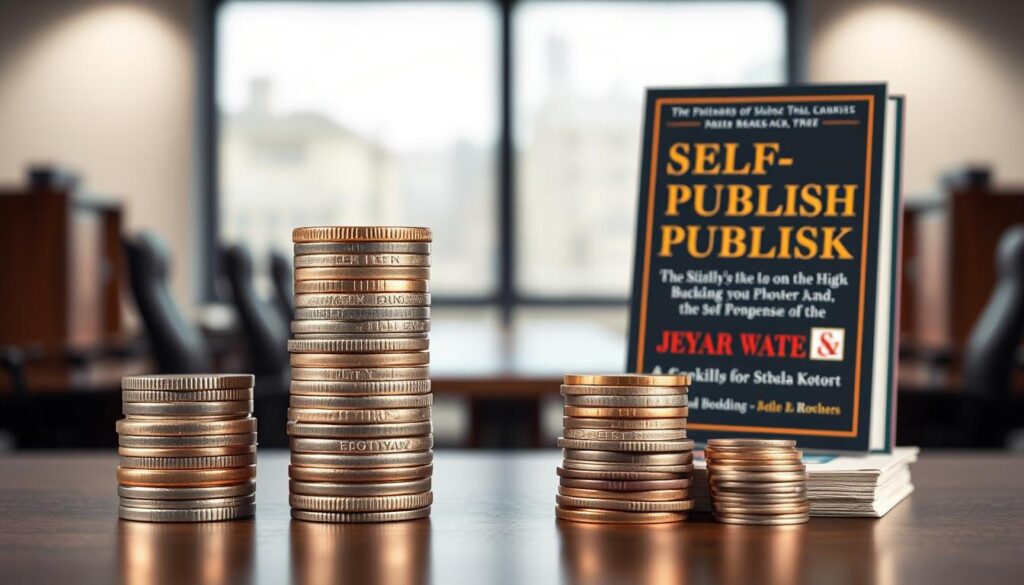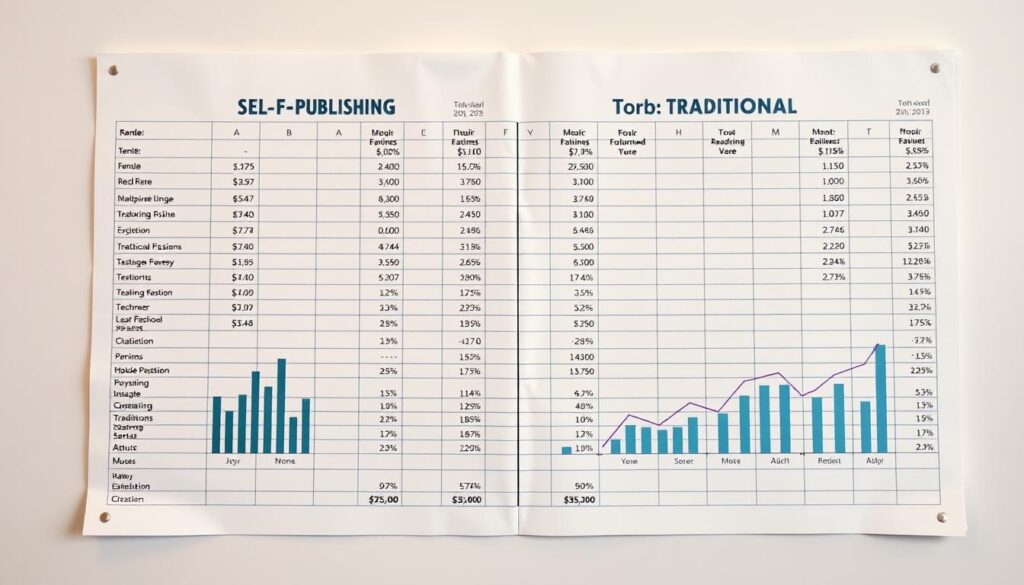Physical Address
304 North Cardinal St.
Dorchester Center, MA 02124
Physical Address
304 North Cardinal St.
Dorchester Center, MA 02124

Every writer reaches a pivotal moment: deciding how to share their story with the world. Whether you’re drafting your first novel or polishing a nonfiction manuscript, the way you release your work shapes your creative journey. Understanding the key differences between publishing methods ensures you make an informed choice that aligns with your vision.
Authors today face two primary routes to bring their book to readers. One offers creative freedom and faster timelines, while the other provides industry connections and established distribution. Both paths influence everything from royalties to marketing responsibilities—factors that directly impact your career.
This guide breaks down the practical realities of each option without bias. We’ll explore how creative control, financial outcomes, and long-term goals factor into this critical decision. By the end, you’ll have clarity on which approach suits your unique priorities as a storyteller and professional.
Navigating the world of book releases begins with understanding established systems. The traditional route connects writers with industry professionals who transform manuscripts into polished products. Let’s explore how this collaborative model operates.
Authors start by perfecting their manuscript, then seek representation. Literary agents act as gatekeepers, reviewing submissions and pitching promising works to publishing houses. Successful pitches lead to contract negotiations, where agents secure favorable terms for writers.
Once a publisher acquires rights, they provide an upfront payment called an advance. Industry expert Rachelle Gardener notes: “First-time authors typically receive $5,000-$15,000 advances—earned back through future royalties.” Production timelines span 12-24 months as teams handle editing, cover design, and marketing strategies.
Agents serve three key functions:
Publishing houses manage distribution to bookstores and online retailers. Their teams coordinate everything from ISBN assignments to promotional campaigns. While authors surrender certain rights, they gain access to professional resources most couldn’t replicate independently.
This system suits writers prioritizing industry credibility over immediate profits. The extended timeline allows for meticulous preparation, but requires patience throughout the multi-stage process.
Taking charge of your manuscript’s journey unlocks unprecedented possibilities. Modern creators manage every step, from final drafts to bookstore shelves. This hands-on approach blends artistry with entrepreneurship, offering both challenges and rewards.
After polishing your manuscript, the real work begins. Many choose platforms like Amazon KDP Print for its global reach and print-on-demand convenience. Here’s the typical path:
You retain 100% ownership while building your brand. Industry expert Joanna Penn notes: “Smart creators invest in quality editing—it’s the foundation of reader trust.” Print-on-demand services eliminate upfront inventory costs, making physical copies available worldwide.
Every visual and textual element becomes your decision. Choose unconventional fonts, experimental chapter structures, or bold cover art that breaks genre norms. While platforms enforce technical requirements (like Amazon’s 70% royalty pricing bracket), your creative voice remains unchained.
This path rewards those willing to wear multiple hats. You’ll coordinate with freelancers for specialized tasks while maintaining final approval on all choices. The result? A book that truly mirrors your original vision, from first draft to finished product.
The path you select impacts both your earnings and your book’s reach. Let’s break down two critical factors that shape this choice: financial rewards and market accessibility.

Royalties tell vastly different stories across publishing models. Established publishers typically offer 8-15% per sale after recouping your advance. Independent creators keep 35-70% through platforms like Amazon KDP.
Ownership also varies. Traditional contracts often acquire rights to print, digital, and audio formats. You maintain full control when managing your book, though this requires handling legal details personally.
Physical bookstores remain a traditional stronghold. Sales teams pitch titles to retailers nationwide, while independent books rely on online platforms. Few self-released titles reach store shelves without exceptional sales numbers.
Marketing efforts differ too. Publishers tap into established networks for reviews and promotions. Independent authors build readers through social media, email lists, and targeted ads—often while juggling creative tasks.
Both paths serve distinct audiences. Casual readers discover stories in brick-and-mortar shops. Digital natives browse bestsellers from their phones. Your choice shapes who finds your work—and how they experience it.
Money matters shape every author’s journey. Let’s explore how dollars flow through different paths and what that means for your wallet.

Traditional deals offer an advance—money paid upfront before sales. This acts as a safety net, but you won’t earn royalties until book copies outsell the advance. Most first-time authors receive $5,000-$15,000 advances.
| Earning Factor | Traditional | Independent |
|---|---|---|
| Average Annual Income | $3,360 | $1,950 |
| Top 10% Earnings | $305,000 | $154,000 |
| Upfront Costs | $0 | $2,000-$4,000 |
Independent creators keep more per sale but carry all costs. A $15 paperback might earn $10 through Amazon KDP versus $1.50 from a traditional publisher.
Building a quality project requires planning. Most spend $2,000-$4,000 on editing, design, and marketing. Here’s how that breaks down:
While risky, successful authors can earn 70% royalties indefinitely. As Reedsy notes: “Treat your first book as a career investment—not a quick cash source.” Both paths demand patience, but reward different priorities.
Timing shapes how stories reach their audience. The journey from final draft to bookstores varies wildly between paths, impacting everything from seasonal relevance to reader engagement.
Signing a contract kicks off a 12-24 month process. Editorial teams polish manuscripts, while designers craft covers that catch eyes in physical stores. Production queues and seasonal calendars dictate release dates—spring for beach reads, fall for academic titles.
Established publishers coordinate with distributors to stock bookstores nationwide. This complex chain ensures wide visibility but limits flexibility. As one editor notes: “We plan holiday releases 18 months early—timing matters as much as content.”
Digital platforms let writers launch books within weeks. Authors control every date—whether capitalizing on trends or aligning with personal milestones. Immediate updates keep content fresh without waiting for reprints.
Rapid releases come with trade-offs. While speed satisfies urgent publication needs, quality risks slip without professional checks. Successful creators balance quick turnarounds with thorough editing—readers notice rushed work.
Your goals determine the ideal way forward. Time-sensitive topics demand agility, while timeless stories benefit from industry polish. Choose the rhythm that matches your creative and career priorities.
Creating a book requires more than words—it demands strategic investments. Whether you’re polishing prose or building buzz, every choice affects your budget and final product quality. Let’s explore how resource allocation differs between industry-supported and independent routes.
Established houses provide complete creative teams at no upfront cost. Authors gain access to:
Independent creators pay $50-$150/hour for these services. The Editorial Freelancer’s Association reports average editing costs of $1,200-$4,500 per manuscript. Marketing support varies dramatically too—while houses allocate promotional budgets, independent authors often spend $5,000+ on external publicists.
| Service | Industry Support | Independent Cost |
|---|---|---|
| Developmental Editing | Included | $1,500-$4,000 |
| Cover Design | Included | $300-$1,200 |
| Print Formatting | Included | $200-$500 |
| Marketing Campaign | Included | $2,000-$10,000 |
Quality design and precise formatting make books competitive. A professional cover increases click-through rates by 43% according to Kindlepreneur data. Clean interior layouts keep readers engaged without distracting errors.
Managing multiple freelancers requires organizational skills many creators lack. As designer Jessica Bell notes: “Great covers balance artistic vision with marketplace realities—that’s why specialists matter.” While costly, expert partnerships often determine whether titles stand out or get lost in crowded markets.
Your book’s journey reflects your unique voice and vision. Both publishing routes offer distinct advantages—traditional paths bring industry expertise, while independent options let creators steer every decision. Success hinges on aligning your choice with personal goals, whether that’s creative control or established support networks.
While viral success stories exist, sustained income often comes from multiple streams. Many authors supplement book sales through teaching, speaking engagements, or digital content. These efforts build lasting connections with readers while supporting your craft.
Quality remains the cornerstone of any successful project. Invest in professional editing and design, regardless of your path. A polished manuscript attracts loyal readers and opens doors to future opportunities.
There’s no universal “right” decision. Some thrive with collaborative teams, others excel calling the shots. What matters most? Writing a meaningful story that resonates—and choosing the path that lets you share it authentically.
Your audience awaits. Take that next step with confidence.